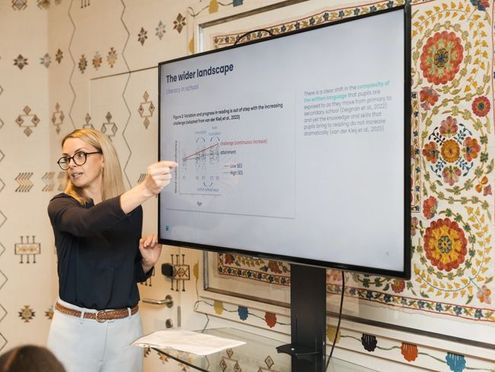About the Pupil Premium Grant
Education, by its nature, is egalitarian. Education, through its pursuit of providing enrichment and opportunity, recognises the same fundamental worth inherent in all learners. Regardless of background or socioeconomic status, all deserve the same chance to attain those opportunities through education. The Pupil Premium Grant, introduced in 2011 by the coalition government, is perhaps the most egalitarian aspect of England’s education system. Put succinctly by the DFE: ‘Pupil premium is funding to improve education outcomes for disadvantaged pupils in schools in England.’ It serves as the most obvious measure to level the playing field, in regard to the attainment gap in England. Any student that has been eligible for free school meals in the last six years, or is looked after by the local authority, meets the criteria of a disadvantaged student.
The ramifications of COVID-19 on the attainment gap are significant and ongoing. By the EEF’s estimations alone, the pandemic has potentially ‘reversed a decade of progress in closing the attainment gap (Francis, 2021). There has never been a more pressing time to address inequality within education- to create an environment in which the complex needs of disadvantaged learners are acutely understood and addressed, allowing them every chance to flourish.
The problems of inequality and attainment are inextricably connected to literacy in the UK. It’s widely established that there is a ‘proven link between poverty and social disadvantage and low levels of literacy’ (Thompson, 2017). These issues may manifest in a myriad of ways; a restricted vocabulary, minimal exposure to enriching texts and experiences, and difficulty in reading comprehension - culminating in lower levels of attainment in literacy, compared to peers. That’s not to say this is the experience of all disadvantaged students. Instead, social inequality has a tangible effect on a student’s academic experience. Said inequality has to be addressed in school to give these students the chances they deserve.
The government allocates £1385 per primary school pupil premium student per year. Secondary schools receive £985 per pupil premium student per year. This funding leaves a wide scope to develop a comprehensive strategy, to meet the needs of disadvantaged students.
With the introduction of the DFE’s uniform pupil premium plan template, coupled with a central focus on evidence-based strategies - now is the time for school leaders to devise long-term plans that elicit change. Literacy sits at the heart of this change.
How does a school decide how to spend the Pupil Premium grant?
The needs of a disadvantaged cohort will vary at every school. Therefore, staff are best placed to decide how to utilise pupil premium funding, as they’re acutely aware of the needs of their cohort. School leaders can couple their areas of expertise with their local knowledge, to judge which is the most appropriate course of action.
The EEF recommends that this understanding can be refined through diagnostic assessments, collaboration between school leaders, and scrutiny of any internal data available for review. It’s crucial that the diagnostic assessments are purpose-built to provide insight into a learner’s thought process, strengths and areas for improvement. Quizzing elements that shed light on vocabulary acquisition and reading comprehension can arm you with this data. Questions focused on grammar proficiency, for example, can allow staff to discern the needs of an individual, class or year group.
The actionable data provided then must be used to influence decision-making. Bearing in mind the complex challenges facing disadvantaged students, wider systemic and societal barriers need to also be considered when devising a strategy: for instance, how to better address fluctuations in attendance or avenues in which to provide rich cultural experiences.
Schools then need to research which measures will address the issues facing their disadvantaged cohort. It's clear that word of mouth, such as working in tandem with experiences at a previous school, influences staff spending decisions (Morris, R. and Dobson, G. 2020). However, there is now a mandate and requirement for evidence-based strategies to become the focal point of any pupil premium plan. This can be achieved by reviewing evidence summaries, which the EEF provides. It’s also important to carefully examine solutions from external providers.
Finally, it’s important that discussions do not exist within a vacuum. Pupil premium plans become transformative when the grant sits ‘at the heart of a whole school effort, with all staff understanding the strategy and their role within it.’ (Collins, K. 2019). The role of teaching is collaborative by design, this means educators can devise a plan that is shared by all staff. From this, a tiered approach should manifest - one that prioritises high-quality teaching, targeted academic support and rigorous wider strategies.
Closing the attainment gap through literacy improvement
As more research emerges, the attainment gap continues to be tangible in evidence. By the end of KS4, learners from disadvantaged backgrounds were 19.2 months behind their peers. Hart and Risley explored how this gulf begins before learners even step foot in a school. By age three, the word gap between children from advantaged and disadvantaged families can reach upwards of 30 million (Hart, B. and Risley, T., The Early Catastrophe, 2003).
The crux of the issue is that disadvantaged learners are more likely to enter education with lower levels of exposure to a diverse range of vocabulary, as well as experiences that can induce the learning of said vocabulary. Their reality may be one in which a parent may be working two jobs, unable to be completely attentive to the learning needs of the child. Alternatively, foundational texts may not be available to foster the building blocks of reading comprehension. The scope for cultural enrichment may also be limited - children from more affluent backgrounds may be able to afford trips to the theatre, museums and even other countries, while learners from disadvantaged backgrounds miss out on this cultural capital.
Anecdotal evidence conveys this gulf in experience. A pupil premium leader for an unnamed inner-city school remarked how many of their students had never even visited the seaside. The deficit in access to cultural capital manifests in vocabulary acquisition. Cultural capital drives vocabulary learning before schooling begins, affording some learners the ability to scaffold knowledge before their education has started. Vocabulary is a tangible marker of this deficit in action, as well as a predictor for later academic success.
Transformative Pupil Premium plans must implement measures that heighten the chances of their developing cultural capital, which in turn drives literacy improvement.
Ensuring your school uses the Pupil Premium grant effectively
The next step is ensuring any programme employed to support literacy is adequately understood and masterfully used by all involved staff. This efficacy is achieved through staff becoming literate in the governing and reporting aspects of the programme. Reactive decisions then need to be made, based on the data that’s extrapolated.
When ensuring a successful implementation of a pupil premium strategy, the EEF asks, ‘Does the strategy provide the necessary professional development and support for staff to implement the approach successfully?’ CPD for any dedicated programme is essential to achieving this proficiency. All staff, even those tangentially involved in the running of a specific programme, should undergo multiple training sessions. Questions can be raised and answered in real time, alleviating any concerns and reaffirming key goals. The shared mission of improving literacy outcomes will be crystallised - as well as the means by which to achieve it.
At the end of the training phase, all staff could be confident in monitoring aspects of student engagement (for example), celebrating learners' progress and assessing vocabulary acquisition. In this sense, evidence can be accessed which will reveal whether the initiative is effective in changing learning outcomes. Quantitative evidence can be gained. An example would be the number of Tier 2 words being used in student writing, following exposure to a Pupil Premium initiative.
A key factor in ensuring this process takes place is a clear and constant line of communication with any external provider. Through this connection, the provider can become attuned to the specific needs of the school. For example, Bedrock schools have designated Account Managers that coalesce with staff in devising a bespoke implementation plan, aligning with the effective practice purported by the EEF. This personable service can result in a plan that drives positive learning outcomes. The implementation strategy, coupled with the ability to consistently appraise and reappraise data, means that using Bedrock within a pupil premium plan ensures the strategy becomes tailored and evidence-based.
It’s also important to note an important tension that exists in devising Pupil Premium strategies. Whilst the EEF and DFE emphasise the importance of providing empirical evidence in demonstrating positive learning outcomes, this cannot be at the expense of other qualitative extracurricular measures. School trips, word-rich home environments and even a PE kit can all make immeasurable differences in the quality of a disadvantaged student’s schooling experience.
As we have previously explored, home is where the attainment gap begins. So any effective PP strategy would also seek to have a positive influence over home dynamics, addressing the gap beyond the school gates. Therefore, it would be beneficial to ensure any edtech solution employed provides a platform to involve parents.
Within the Bedrock framework, staff can share login details with parents and guardians of all users, ensuring access to a parental account. Through this communication and collaboration, parents and guardians can become allies and champions that celebrate vocabulary learning inside the home. These communications can aid in producing a knowledge-rich and celebratory environment.
How Bedrock supports literacy for Pupil Premium learners
Bedrock's core curriculum addresses some of the complex factors that coalesce to maintain the vocabulary and attainment gap. Tier 2 words are explicitly taught through enriching contexts, such as our bespoke fiction and non-fiction texts, that broaden learners’ experiences.
Matt Bromley asserts that an individualised approach to addressing barriers is a core feature of any effective Pupil Premium plan. It’s evident that the way in which Bedrock’s curriculum is structured can meet these criteria. Through the Alpha test, learners are assigned to a vocabulary curriculum perfect for their literacy ability, helping learners begin their vocabulary journey with challenging but accessible language. The content of the curriculum equips learners with a wide range of ambitious Tier 2 language, all immersed in those culturally rich fiction and nonfiction texts - altogether, Bedrock’s approach to improving vocabulary tackles the specific needs of pupil premium learners, closing the attainment gap.
Finally, Bedrock provides a platform for staff to use their creative tendencies, entwined with their local knowledge, to aid in addressing issues of inequality beyond a typical educational setting. By taking on a programme like Bedrock, the EEF’s recommended criteria of high-quality teaching, targeted academic support, and wider strategies are already being met. However, by using Bedrock’s array of topics, staff are able to double down on these wider strategies.
It’s entirely possible for schools to provide transformative and enriching experiences for disadvantaged students. These experiences can be intrinsically related to topics students are encountering on Bedrock. This provides a tangible way to scaffold a disadvantaged student’s vocabulary learning, whilst simultaneously providing a rich cultural experience.
For example, a ‘Bedrock Adventure’ could take primary school students to Winchester Science Centre and Planetarium, to expand upon the knowledge they’ve acquired in Bedrock's Solar System Block. The centre provides exhibits and shows that adapt to fit the age of the group attending. There is also a 60% discount for schools with over 14% students eligible for FSM. The need and want for disadvantaged students to have access to these cultural experiences is demonstrated in this offering alone. In a secondary setting, outstanding learners working on Block 11 could participate in a free walking tour in Holborn, centred around the life of Charles Dickens. Walking down cobbled streets, their previous learning comes alive and vivid in a manner that might not have been previously possible.
Fundamentally, ‘Cultural capital takes one tangible form: a pupil’s vocabulary.’ (Bromley, M. 2019). Therefore, a transformative Pupil Premium plan must prioritise vocabulary acquisition. The strategy should also extend beyond quality teaching and targeted support, seeking to expose disadvantaged students to rich cultural experiences. These experiences can be pivotal if they are inextricably linked to the terms and contexts that students have been exposed to in their vocabulary curriculum. Staff must then constantly reappraise their approach, to continuously improve literacy outcomes. To ensure this level of awareness, it’s crucial to use a tool that is evidence-based, equipping staff with actionable data to streamline and adapt their class-time decisions. When these factors align, an environment can form that helps learners realise possibilities they may never have dreamt of.
Ultimately, when the Pupil Premium grant is used to propel literacy improvement, it is no understatement to say that its effects can be life changing.




